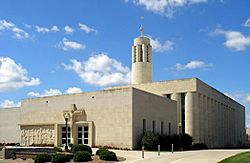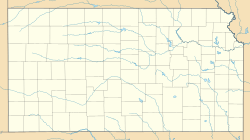Sacred Heart Cathedral (Salina, Kansas) facts for kids
Quick facts for kids Sacred Heart Cathedral |
|
|---|---|
 |
|
| 38°50′28″N 97°36′43″W / 38.841°N 97.612°W | |
| Location | 118 N 9th St. Salina, Kansas |
| Country | United States |
| Denomination | Roman Catholic |
| History | |
| Status | Cathedral |
| Dedication | Sacred Heart of Jesus |
| Architecture | |
| Architect(s) | Edward J. Schulte |
| Style | Modern |
| Completed | 1953 |
| Specifications | |
| Number of spires | One |
| Materials | Limestone |
| Administration | |
| Diocese | Salina |
The Sacred Heart Cathedral is a special church in Salina, Kansas, United States. It is the main church for the Catholic Diocese of Salina. A diocese is like a church district led by a bishop. This cathedral is the second main church for the diocese. The first one was in Concordia, Kansas.
Contents
History of the Cathedral
The Catholic Diocese of Concordia was created by Pope Leo XIII in 1887. Later, in 1944, Pope Pius XII decided to move the main church location to Salina. So, Sacred Heart Church became the new cathedral.
An architect named Edward J. Schulte from Cincinnati, Ohio, designed the new cathedral building. Construction began when the cornerstone was placed on June 4, 1951. The church was officially opened and blessed by Bishop Francis Augustine Thill on June 6, 1953. In 1998, the inside of the church was updated. A larger gathering area and a church hall were added in 2000.
Cool Architecture and Design
The design of Sacred Heart Cathedral shows off the farming areas of Northwestern Kansas. It also connects to important parts of the Catholic Church.
Outside the Cathedral
You might notice that the sides of the cathedral are rounded. They look like the big concrete grain elevators you see in farm fields. These elevators store wheat, which is a main crop in the area. The church's rounded shape reminds people that the Church is like God's "granary." It's a place where people get spiritual food, like the Eucharist.
The bell tower of the cathedral is also round. It looks like a farm silo. Just as farm animals gather at a silo for food, people gather at the church. They come for spiritual food from Christ, who is called the Good Shepherd.
At the main entrance, there is a cool carving called a bas relief. It shows people walking together. These figures include a farm family, priests, and religious people helping the bishop carry a cross. A Capuchin friar is also shown kneeling in prayer. The carving has a quote from the Bible that says, "He who does not take up his cross and follow me is not worthy of me."
Inside the Cathedral
When you go inside, you'll see a large baptismal font shaped like a cross. It's in the gathering area. Nearby, there's a special artwork called a triptych. It has three parts and shows important figures. These include the Sacred Heart of Jesus, who the cathedral is named after. It also shows Our Lady of Perpetual Help and St. Francis of Assisi, who are also important to the diocese.
The main part of the cathedral, called the nave, has huge pillars. They are about 30 feet (9.1 m) around! At the bottom of the bell tower, there's a room that used to be a baptistery. Now, it has a shrine to Our Lady of Guadalupe. The statue in this chapel came from a small church that closed in 1965.
On the back wall of the cathedral, there's another bas relief of the Sacred Heart. Below it, there's a Latin phrase: Cor Jesu, inflama cor nostrum amore tui. This means "Heart of Jesus, inflame our hearts with your love." Along the walls, there are twelve crosses with candles. These represent the Twelve Apostles. They mark the spots where the walls were blessed with holy oil when the cathedral was dedicated. The fourteen Stations of the Cross are carved into the east wall.
Sanctuary and Windows
The front area of the church, called the sanctuary, has a very tall crucifix. It is about 20-foot (6.1 m) high! Around the crucifix, there's a circular canopy with three Latin phrases. They say:
- Cor Jesu, spes in te morientium (Heart of Jesus, hope of those who die in you)
- Domus Dei et porta coeli (House of God and gate of heaven)
- Cor Jesu, omni laude dignissimum, salve in te sperantium (Heart of Jesus, most worthy of all praise, salvation of those who hope in you)
The marble legs of the Altar were made from parts of the old communion rail. The altar holds special items called relics from St. Boniface and St. Clement. The Blessed Sacrament is kept in the chapel of the Blessed Virgin Mary.
The beautiful stained glass windows in the cathedral were designed by Anton Wendling from Aachen, Germany. They were put together by Erhardt Stettner in Milwaukee, Wisconsin. These windows are about 25-foot (7.6 m) high and show different saints. There are also five smaller windows above the confessionals.
The Pipe Organ
The cathedral has a large pipe organ. It was first built in 1926 for the old Sacred Heart Church. When the new cathedral was being built in 1952, the organ was moved and rebuilt there. Over the years, it has been updated and restored.
The pipe organ is located near the altar at the front of the cathedral. Its pipes are hidden in a special room on the side wall. The organ has a traditional console, which is the part with the keys and pedals. It has three keyboards (called manuals) and a pedalboard for playing with your feet.
See also
 In Spanish: Catedral del Sagrado Corazón (Salina) para niños
In Spanish: Catedral del Sagrado Corazón (Salina) para niños



